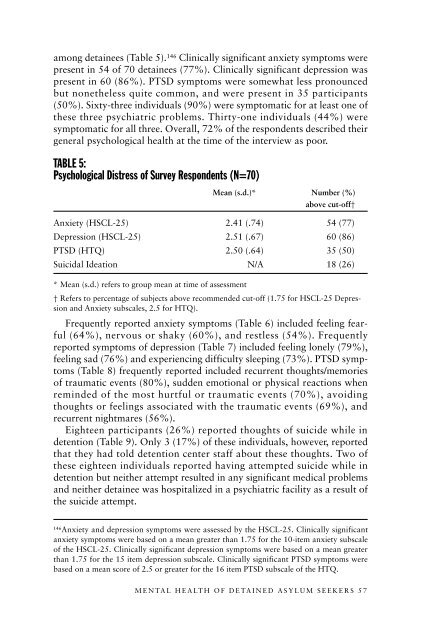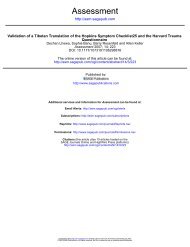From Persecution to Prison - Bellevue/NYU Program for Survivors of ...
From Persecution to Prison - Bellevue/NYU Program for Survivors of ...
From Persecution to Prison - Bellevue/NYU Program for Survivors of ...
You also want an ePaper? Increase the reach of your titles
YUMPU automatically turns print PDFs into web optimized ePapers that Google loves.
among detainees (Table 5). 146 Clinically significant anxiety symp<strong>to</strong>ms werepresent in 54 <strong>of</strong> 70 detainees (77%). Clinically significant depression waspresent in 60 (86%). PTSD symp<strong>to</strong>ms were somewhat less pronouncedbut nonetheless quite common, and were present in 35 participants(50%). Sixty-three individuals (90%) were symp<strong>to</strong>matic <strong>for</strong> at least one <strong>of</strong>these three psychiatric problems. Thirty-one individuals (44%) weresymp<strong>to</strong>matic <strong>for</strong> all three. Overall, 72% <strong>of</strong> the respondents described theirgeneral psychological health at the time <strong>of</strong> the interview as poor.TABLE 5:Psychological Distress <strong>of</strong> Survey Respondents (N=70)Mean (s.d.)* Number (%)above cut-<strong>of</strong>f†Anxiety (HSCL-25) 2.41 (.74) 54 (77)Depression (HSCL-25) 2.51 (.67) 60 (86)PTSD (HTQ) 2.50 (.64) 35 (50)Suicidal Ideation N/A 18 (26)* Mean (s.d.) refers <strong>to</strong> group mean at time <strong>of</strong> assessment† Refers <strong>to</strong> percentage <strong>of</strong> subjects above recommended cut-<strong>of</strong>f (1.75 <strong>for</strong> HSCL-25 Depressionand Anxiety subscales, 2.5 <strong>for</strong> HTQ).Frequently reported anxiety symp<strong>to</strong>ms (Table 6) included feeling fearful(64%), nervous or shaky (60%), and restless (54%). Frequentlyreported symp<strong>to</strong>ms <strong>of</strong> depression (Table 7) included feeling lonely (79%),feeling sad (76%) and experiencing difficulty sleeping (73%). PTSD symp<strong>to</strong>ms(Table 8) frequently reported included recurrent thoughts/memories<strong>of</strong> traumatic events (80%), sudden emotional or physical reactions whenreminded <strong>of</strong> the most hurtful or traumatic events (70%), avoidingthoughts or feelings associated with the traumatic events (69%), andrecurrent nightmares (56%).Eighteen participants (26%) reported thoughts <strong>of</strong> suicide while indetention (Table 9). Only 3 (17%) <strong>of</strong> these individuals, however, reportedthat they had <strong>to</strong>ld detention center staff about these thoughts. Two <strong>of</strong>these eighteen individuals reported having attempted suicide while indetention but neither attempt resulted in any significant medical problemsand neither detainee was hospitalized in a psychiatric facility as a result <strong>of</strong>the suicide attempt.146Anxiety and depression symp<strong>to</strong>ms were assessed by the HSCL-25. Clinically significantanxiety symp<strong>to</strong>ms were based on a mean greater than 1.75 <strong>for</strong> the 10-item anxiety subscale<strong>of</strong> the HSCL-25. Clinically significant depression symp<strong>to</strong>ms were based on a mean greaterthan 1.75 <strong>for</strong> the 15 item depression subscale. Clinically significant PTSD symp<strong>to</strong>ms werebased on a mean score <strong>of</strong> 2.5 or greater <strong>for</strong> the 16 item PTSD subscale <strong>of</strong> the HTQ.MENTAL HEALTH OF DETAINED ASYLUM SEEKERS 57



